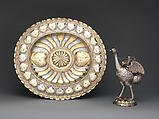Ewer in the form of an ostrich and basin
Ewer by Marx Weinold German
Basin by Johann Mittnacht I German
Formerly part of the Rothschild collection at Mentmore Towers, this ewer and basin were created either for the washing of hands during festive banquets or for display on a parade buffet, with the basin shown upright to exploit its light-reflecting plain, lobed, and partially gilded areas (see cats. 6, 7).[2] The ewer is in the form of an ostrich walking on muscular legs, its claws pressing powerfully into the ground to indicate rapid movement; its base fits onto the basin’s central sun motif, which allows the two to be displayed together.[3] Cupid’s reclining pose and his tight control of the bridle chain attached to the animal’s beak support the impression of activity. The god of love is seated on the detachable gilded cover, which is shaped and ornamented like a fringed saddle blanket and functions as a stopper, concealing a rectangular shaft.
The myth that the forgetful female ostrich abandons the nest after only three days of watching the eggs was connected to the Passion of Christ (fig. 51).[4] It was believed that the eggs were incubated instead by the rays of the sun—symbolized by the decoration of the basin—which evokes a parallel to the Immaculate Conception.[5] Steering the flightless and apparently iron-devouring giant bird (see cat. 22)[6] in his desired direction, the winged Cupid efficiently uses his bow and arrow, the sources of his power, to set his plot in motion—Amor vincet omnia, heavenly and earthly love conquers all.
Footnotes
(For key to shortened references see bibliography in Koeppe, Making Marvels: Science & Splendor at the Courts of Europe: The Metropolitan Museum of Art, 2019)
1. Seling 2007, p. 44, no. 0980 (Augsburg town mark), p. 335, no. 1671 (Weinold maker’s mark), p. 348, no. 1710 (Mittnacht maker’s mark).
2. The ewer is men-tioned by the 5th Earl of Rosebery in his travel diary, in which he refers to the object as a “cup.” He noted that, on August 12, 1885, he entered the Frankfurt shop of the antique dealer Goldschmidt in the company of his friend Count Herbert von Bismarck, the son of the Prussian chancellor: “Goldschmidt has a wonderful Augsburg cup for which he asks 25,000 marks to which I fear I shall succumb.” Quoted in Sotheby’s 1999, p. 70, under no. 36; see also Dalmeny House 1984, p. 16. For the ewer, see Sotheby’s 1977, vol. 2, no. 654. Bernhard Heitmann, curator emer-itus and silver expert, Museum für Kunst und Gewerbe Hamburg, examined the set in Maastricht in 2014 and called it a typical “Green Vault or Kremlin Armory object” (personal communication). See also Stahl 2002, figs. 30–32.
3. For related examples, see Wagner 1985; Laloux and Cruysmans 1994, pp. 30–31. On the iconography of the ostrich egg, see Bock 2005; Wolfram Koeppe in A. Moore, Flis, and Vanke 2018, pp. 311–12, nos. 44, 45.
4. Bock 2005; D’Elia 2015, p. 141, fig. 132.
5. Bock 2005, pp. 75–77.
6. Koeppe 2004, pp. 87–89.
Due to rights restrictions, this image cannot be enlarged, viewed at full screen, or downloaded.
This artwork is meant to be viewed from right to left. Scroll left to view more.




